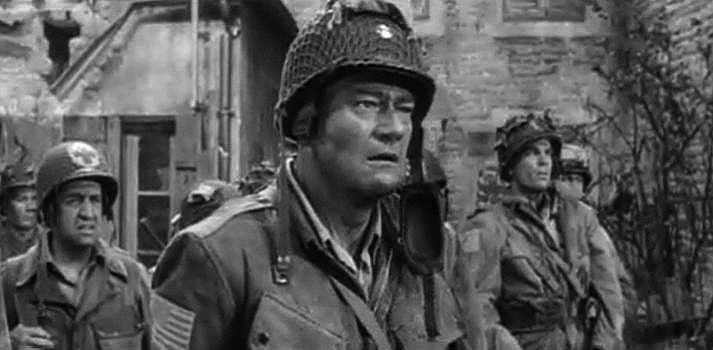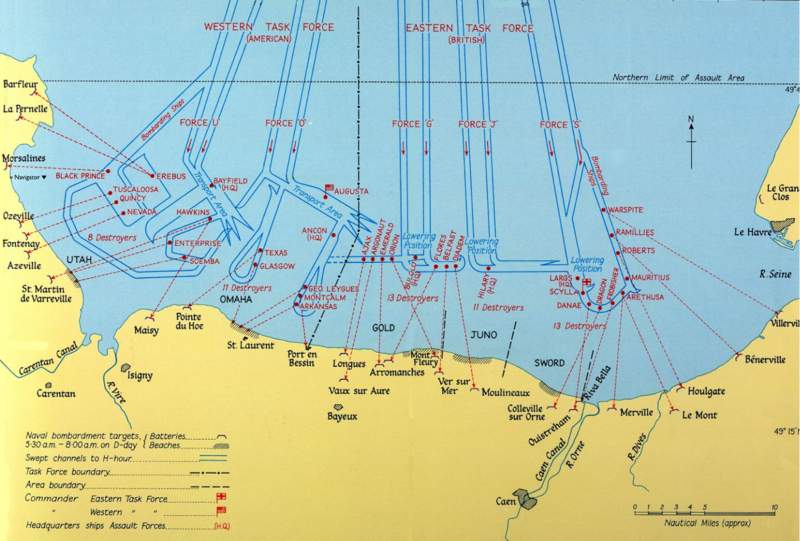 |
| John Wayne in the 1962 film The Longest Day |
 |
| Screenshot of the Normandy landing from Saving Private Ryan. |
Canada was heavily involved in the fighting during both WWI and WWII. As a nation and military force, Canada does not hold the same level of prestige as Britain, the United States, France, Germany, etc. In both cases, it is because the Canadian efforts have been seen as joint efforts with others. In WWI, Canada was a dominion of the British Empire, and did not even hold sufficient right to declare war on its own: once Britain was in, Canada was in, no ifs, ands, or buts about it. As for WWII, although Canada had attained enough international clout to issue its own declaration of war and handle its own international affairs, it was still popularly conceived as "British".
What this means is that like the other Commonwealth nations (ex. Australia and New Zealand), Canadians have taken particular responsibility in remembering their own achievements from WWI and WWII. For Canadians, then, we then sought out instances where our soldiers have gone above and beyond the call of duty to create something significant not just to our own history, but to the wars' progression overall. In WWI, that lot fell to Vimy Ridge (April 9-12, 2917); and in WWII, although the credit could be more diversely distributed, most of the emphasis has fallen upon Juno Beach.
 |
|
Infantrymen of The Highland Light Infantry of Canada
aboard LCI(L) 306 of the 2nd Canadian (262nd RN) Flotilla en route to
France on D-Day, 6 June 1944. (Photograph by Lieut. Gilbert Alexander Milne)
|
Now, I'm not a military historian. I can't tell you the hows of Canada's victory at Juno Beach, or why the Canadians were the first to achieve success. There are plenty of books, websites, etc. addressing that issue, I reckon. All I want to do is give the Canadian troops that took part in D-Day their proper recognition. Hollywood might give us the American story, but D-Day was a joint effort - without each force involved doing its part, the offensive as a whole may not have succeeded.
And I think, for Canada, seventy years later, that's what matters most.
 |
|
Three "D-Day originals" of the Regina Rifle Regiment
who landed in France on 6 June 1944. Ghent, Belgium, 8 November 1944. (Photograph by Lieut. Donald I. Grant)
|
 |
| Private C.L. Jewell of The North Nova Scotia Highlanders, who wears a "D-Day" beard, Normandy, France, 22 June 1944. (Photograph by Lieut. Ken Bell) |
Image Credits
Screenshot from The Longest Day (c) 20th Century Fox
Screenshot from Saving Private Ryan (c) Amblin Entertainment
Map of Normandy Beaches (c) HMSO (Her Majesty's Stationary Office) and the National Archives (UK)
All photos of Canadian forces in 1944 (c) Library and Archives Canada



Many thanks to our Canadian friends and allies, and all other Allied veterans for their sacrifice and bravery during this enormous undertaking. You have some wonderful pictures here Kita.
ReplyDeleteThank you also for mentioning Australia and New Zealand in this article. Australians also fought on D-Day, many with the Royal Australian Airforce, the Navy and also some Army under British command.
Seven of our veterans traveled to France, with our Prime Minister for ceremonies at Bayeux, and six veterans were awarded the French Legion of Honour.
And now I'm learning something new myself. I hadn't known there were Australians there on D-Day (do you know which beach, by any chance?), so that's great to hear :)
DeleteAlso, I'm glad you liked the pictures. It seems that we had some photographers among the military at the time, and these pictures were the result. It's great that Library and Archives Canada has A) posted them online and B) put them in the public domain. That way, I can share these without any worries. And, yes, there are some really nice pics out there - my favourite is the "D-Day beard" one, because growing a beard to count up from something is a bit of a Canadian tradition (ex. NHL playoff beards today, where guys grow out a beard for as long as their favourite team is in the playoffs). I'd had no idea it went back as far as WWII, but it seems fitting (and kudos to his COs for allowing it :P)
Sorry K, not ignoring you, been exhausted past two days having birthday celebrations for my little nephew. So tired!
DeleteIn the D-Day operation itself our numbers were fairly small (but of course we're only a small country!) - about 3,000 overall. The vast majority were RAAF pilots involved in aerial bombing, some doing recon, some towing gliders for the invasion - I saw some good interviews with a surviving pilot from my home city on TV this week. Navy personnel and merchant seamen were involved and a few Australian officers even commanded landing craft.
Landing craft commanders landed at both Sword and Juno. Though, I am not sure if they went ashore as they were likely RAN (Navy). As for actual infantry, only a small number were involved on 6th June, I think on Gold.
We supplied indirect support too, mainly Navy, engaged in destroying German submarines for the invasion. More numbers were involved subsequently in the battle for France than in the actual D-Day initial invasion.
I did not know about the D-Day beard, so it was great to learn about that, and I really like that the tradition is continued in Canadian culture.
Right now, this is the only instance of a "D-Day beard" I've seen, and I don't know if the 21st century playoff beards share a common origin with that one shown here. But I do think it's rather cute, all things considered :)
DeleteAnd thanks for the info on the Aussies at D-Day - that's definitely a valuable addition to any discussion on the subject, I think :)